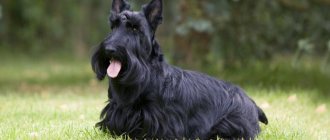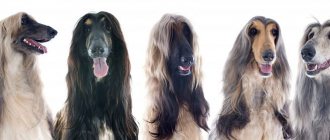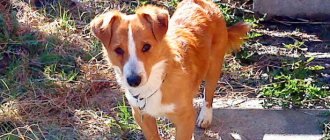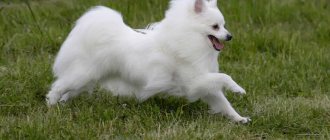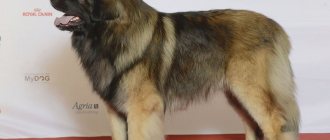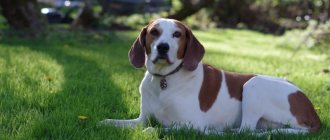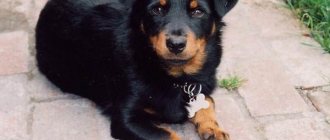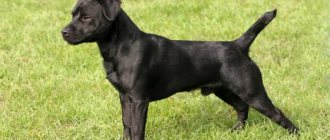A little history
Scientists studying these animals agree that Molossians (dogs) descended from a common ancestor. The first mention of such dogs dates back to 640 BC. e. The name of this group apparently originated from Molossia. This ancient state was located in the western part of Greece. It was from there that these animals came to the territory of the Ancient Roman Empire. The Romans appreciated these large, hardy dogs. In the process of fighting, the dogs of the Molosser group were part of the Roman legions. In peacetime, they were released into the arena to fight gladiators or wild beasts. Subsequently they spread throughout Europe.
Appearance and character
All dog breeds included in the Molossian group have common features both in appearance and in their temperament.
A dog whose eyes fall out: a review of breeds
Appearance:
- Tall (up to 65 cm);
- Powerful, athletic body;
- Loose skin;
- Strong jaw;
- Droopy ears;
- Tired, sad look.
Character:
- Self confidence;
- Kindness towards others;
- Calm;
- Devotion;
- Fearlessness;
- Intelligence.
Important! The negative aspect of Molosser dogs is their poor health and short life expectancy.
Molosser: dog breeds
Today this group includes about 30 different breeds. The most popular are Rottweilers, St. Bernards, Great Danes, Mastiffs, Boxers, English Bulldogs, Central Asian and Caucasian Shepherd Dogs. All of them have a wide chest, developed muscles and more or less hanging skin. Many of them are characterized by increased aggressiveness towards other relatives. Molossians, dogs whose description can be read below, are distinguished by their stubborn character, but at the same time they do not strive to dominate.
Molosser group
Dog handlers still cannot decide who the ancestor of the Molossian dogs was. Most scientists agree that they descended from Tibetan dogs that acclimatized on Greek territory. Another version is that the breed group originated from Caucasian and Central Asian shepherd dogs, similar in appearance to the Tibetan mastiff.
The Molossians received their unusual name in honor of the family of rulers of the Empire (the territory of Ioannina in modern Greece). In ancient times they were used as a military weapon. Equipped with armor, a pack of dogs burst into the enemy's ranks, causing irreparable damage.
By the way, mention of the ancient Molossians is found in the manuscripts of Aristotle, Homer and Aesop. In Greek mythology, dogs of the Molossian group are also repeatedly described. Some historians claim that these animals took part in the campaign through the Alps with Hannibal.
Medieval armor of dogs
At the end of the 20th century, on the territory of the USSR, they tried to use Molossians as service dogs. This experiment failed. The dogs were good at finding the scent, defending the territory, and adapting to any weather conditions, but they only recognized people who were able to prove their leadership and gain respect. This approach was impossible in service nurseries. The work required docile dogs that could easily tolerate changes in ownership.
Due to their highly developed leadership, the Molosser group of dogs is completely unsuitable for beginners. In the wrong hands, these dogs pose a danger to the owner and society.
Situations often occur when dogs from the Molosser group are bred to guard country estates, while devoting little time to training and establishing relationships with the dog.
The expression: “Feeding with a shovel” becomes not a metaphor, but a reality. This is especially true for Caucasian Shepherd dogs, which are popular today.
Without constant communication with humans, Molossian dogs become aggressive and uncontrollable. Chains and small enclosures further aggravate the situation.
A dog raised under constant restrictions can rarely be convinced and corrected. The above situation proves that illiterate handling of Molossians is dangerous.
If the owner understands animal psychology and has a strong character, then it is difficult to find a better friend than Molossian dogs.
What is the largest dog in the world?
World leadership today belongs to the English mastiff named Hercules, born in England. His height is 94 cm and his weight is more than 150 kg!
Dogue de Bordeaux
These animals are considered one of the most prominent representatives of the molossoid group. Dogs of this breed weigh 40-50 kilograms and are 58-68 centimeters tall. The main distinguishing feature of the Dogue de Bordeaux is considered to be a massive head with powerful thick jaws and a pronounced transition from the forehead to the muzzle.
The body of these dogs is covered with short, soft hair. They are characterized by a solid black and piebald, golden or fawn color. The presence of white spots on the paws and chest of the animal is not considered a defect.
Dogues de Bordeaux are not suitable for keeping in city apartments; they need space. In addition, these animals are lazy by nature. Therefore, they need regular long walks and moderate physical activity. Otherwise, the dog will quickly gain weight, which can lead to serious health problems.
History of the Molossians
Molossians are rightfully considered one of the oldest dogs on the planet. Long before the beginning of our era, they lived among the Assyrians, Sumerians and Phoenicians, from where, according to a stable version, they came to the ancient Romans and gained enormous popularity here. Gigantic dogs were used for spectacular bloody battles, protection, and hard work.
This ancient figurine (Mesopotamia, 2nd millennium BC) accurately depicts the outline of a Molossian, although its paws are missing
Already in those ancient times, folk selection of various Molosser breeds began - people selected dogs for their specific needs and bred them. Subsequently, the history of any of the Molossoid breeds was not easy, it knew its ups and downs. Many of them have been under threat of complete extinction more than once - only in the last century this happened twice, after the First and Second World Wars.
Caucasian Shepherd Dog
This is another typical representative of the Molosser group. Dogs of this breed have a complex, independent character. By nature they are not aggressive, but they have a very developed protective instinct. These large dogs should not be kept on a leash. For these animals it is necessary to build spacious enclosures.
Caucasian Shepherds are squat dogs with massive bones and well-developed bulky muscles. Their height is 64-75 centimeters, and their weight is at least 45-50 kilograms. A characteristic feature of these animals is a massive, well-set wedge-shaped head with wide cheekbones and small, widely spaced ears.
Varieties
If we talk about dog breeds that are part of the Molosser group, today there are many of them. They all have their own characteristics that distinguish them from each other. Many of them are especially popular. Among them it is worth noting such as bulldogs, Caucasian shepherds or St. Bernards. To become more familiar with them, you need to consider their description.
Dogue de Bordeaux
These are the brightest representatives who are included in this group. Their weight ranges from 40 to 45 kilograms, and their height can reach up to 70 centimeters. They differ from other breeds in their rather powerful and massive head, as well as very powerful jaws. Great Danes have a pronounced transition from the muzzle to the forehead.
The fur of these animals is small and very soft to the touch. The color can be black, golden, and also fawn.
Some of them have small white spots that are located on both the paws and chest of the dog. However, this is not considered a vice.
It is better not to keep such large dogs in apartments, as they need space to play. Great Danes are very lazy by nature, so they will need exercise as well as regular walking. If this is not done, it can lead to obesity of the animal.
Neapolitan Mastiff
Italy is considered the birthplace of this beauty. The height of dogs of this breed is 61-74 centimeters, weight - from 50 to 70 kilograms. The massive body of the animal is covered with short hair of blue, black or brown shades. The main distinguishing feature of the Neapolitan Mastiff is a wide skull with a short massive muzzle, hanging loose lips and well-developed jaws.
These strong-willed and very stubborn dogs are not programmed to obey instantly. Therefore, training them will require a lot of time and patience. In addition, they overheat easily and do not require increased physical activity. The best activity for the Neapolitan Mastiff is swimming.
These are bright representatives of the Molossoid group. The dogs, photos of which can be seen below, have a calm character. Phlegmatic mastiffs never attack first, with the exception of situations in which their owners are in danger.
Bullmastiff
This is a fairly young breed, the birthplace of which is England. These animals were bred by crossing a bulldog with a mastiff. They were recognized as a full-fledged breed in the 20s of the last century.
These huge, powerful animals instantly become the center of everyone's attention. Bullmastiffs are characterized by well-developed muscles and a wide, powerful chest. The main characteristic feature of these dogs is considered to be a wide square skull with a short muzzle and a wide nose.
The bullmastiff's angular, dense body is covered with smooth, short, close-fitting fur of a brownish-red color. Sometimes there are small white spots on it. The height of these dogs reaches 60-69 centimeters, weight – 45-60 kilograms.
Animals of this breed are suitable for keeping in city apartments and private homes. These massive dogs have a rather lazy character. If they are not persistently pushed towards the door, they will continue to lie on the sofa. Training bullmastiffs is complicated by the fact that they are very capricious. The dog will never carry out a command that, in its opinion, is meaningless.
Newfoundland
Animals of this breed have a powerful, compact and strong body with a straight back line. Newfoundlands have a wide skull with a well-developed occiput and a slightly convex arch. The dog's short, square muzzle is covered with fine, short hair. The height of adult individuals is 66-71 centimeters, weight - 54-68 kilograms.
The Newfoundland's thick coat with a dense undercoat requires regular grooming. In order for the dog to have a neat appearance, it must be periodically combed with a special metal brush. It is advisable to repeat this procedure every three days. You need to bathe your dog as soon as it gets dirty. Once every three weeks, it is recommended to treat the animal with antiparasitic agents against fleas and ticks.
Newfoundlands have a kind, calm and inquisitive nature, making them easy to train. However, their training should be more like a game. During training, you need to take into account that these large, heavy dogs get tired quickly.
Who are Molossians
Not all people know about the existence of this breed of dog, and some simply think that this is a species of some extinct animal. Although these representatives are found on the streets of any city every day. This is a whole group consisting of several breeds. All dogs are similar in internal and external characteristics.
Note! Many works created in ancient times illustrate Molossians, which is already proof of their existence in those distant times.
Their inimitable appearance, powerful appearance, fearlessness, and dedication have done their good work - the dogs have become very popular, in many countries of the world. And as a result of a long period of selection, today there is a great variety of different breeds.
